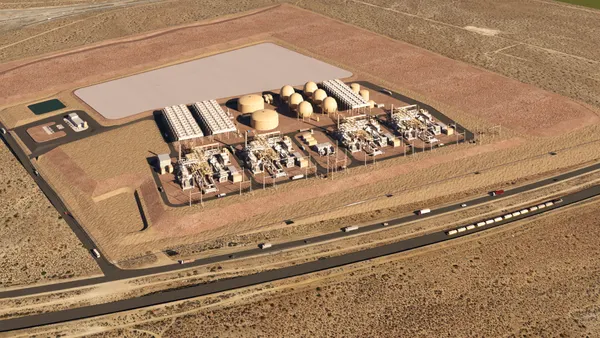Dive Brief:
- The first quarter of 2023 marked the second straight quarter of slowing growth in energy storage installations, according to a report released Wednesday by the consulting firm Wood MacKenzie and the American Clean Power Association.
- The consulting firm attributed the decline to supply chain problems and backlogs of wind and solar projects in interconnection queues.
- Once those problems are resolved, Wood MacKenzie expects a return to growth in new energy storage installations in the second quarter of 2023, followed by continued growth through 2027.
Dive Insight
The energy storage market added 2,145 MWh of new capacity in the first three months of this year.
It marks a 33% drop in energy storage market growth compared to the first quarter of 2022, and a 26% drop compared to last year’s fourth quarter, according to Wood MacKenzie’s and ACP’s latest U.S. Energy Storage Monitor report.
The report's data are from public announcements and analysts who reach out to developers and inquire about energy storage projects.
The drop marks the first time installed capacity has decreased in two consecutive quarters since 2015, when the market energy storage volume was smaller and less predictable, the report says.
Nevertheless, researchers with WoodMac and ACP remain optimistic, noting that the market is growing and many challenges it faces are likely temporary.
"No one should be alarmed that Q4 and Q1 volumes dipped," said Vanessa Witte, a senior analyst for WoodMac's energy storage team.
Growth in the energy storage market is closely tied to growth in wind and solar power because storage batteries are necessary to provide resilience to intermittent resources.
WoodMac and ACP expect growth in energy storage to accelerate once supply chain problems are ironed out and the nation’s power grids work through the backlog of wind and solar projects.
Inflationary pressures are already starting to ease, said John Hensley, ACP’s vice president of research and analytics.
"We saw a 6% decline in system prices compared to the first quarter of 2022," he said.
However, "there's still a question on how quickly things will fully resolve themselves in the solar space, that will continue to be a headwind for hybrid systems pairing the technologies together," Hensley said.
In the meantime, the storage industry is learning to live with those headaches, said Vanessa Witte, a senior analyst for WoodMac’s energy storage team.
"Now that developers are becoming more savvy about transformer or substation circuitry taking a long time [to be shipped], they're starting to procure that much earlier," she said.
And interconnection backlogs will likely start to ease in the coming months, Witte said.
Data for the second quarter of 2023 are not yet available, but the two organizations predict strong growth in the second three months of the year.
"We expect 2023 to be a record year for energy storage deployment, especially as more utilities and more markets understand the benefits and value energy storage brings to their system," Hensley said.
That growth will continue until at least 2027, the report says.














